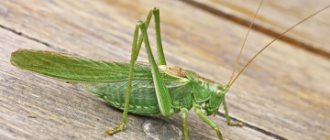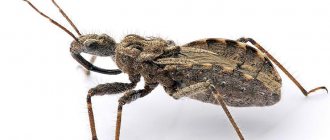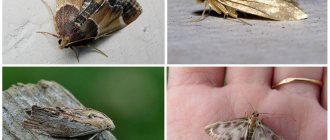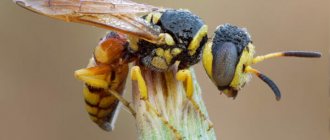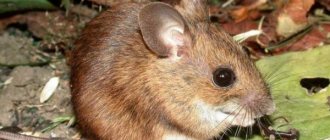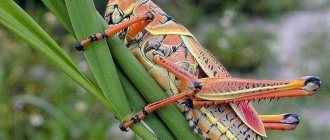- Wild animals
- >>
- Insects
The grasshopper is a herbivorous insect from the suborder Orthoptera, order Orthoptera. To distinguish them from crickets or katydids, they are sometimes called short-horned grasshoppers. Species that change color and behavior at high population densities are called locusts. There are about 11,000 known species of grasshoppers found around the world, often found in grassy fields, meadows and forests.
Origin of the species and description
Photo: Grasshopper
Modern grasshoppers are descended from ancient ancestors that lived long before dinosaurs roamed the Earth. Fossil evidence shows that primitive grasshoppers first appeared during the Carboniferous period, more than 300 million years ago. Most ancient grasshoppers are preserved as fossils, although grasshopper larvae (the second stage in a grasshopper's life after the initial egg phase) are sometimes found in amber. Grasshoppers are divided according to the length of their antennae (tentacles), which are also called horns.
Video: Grasshopper
There are two main groups of grasshoppers:
- grasshoppers with long horns;
- grasshoppers with short horns.
The short-horned grasshopper (family Acrididae, formerly Locustidae) includes both harmless, non-migratory species and the often destructive, swarming, migratory species known as locusts. The long-horned grasshopper (family Tettigoniidae) is represented by the katydid grasshopper, meadow grasshopper, cone-headed grasshopper and shield grasshopper.
Other orthoptera are also sometimes called grasshoppers. The pygmy grasshopper (family Tetrigidae) is sometimes called the partridge or pygmy locust. Leaf-rolling grasshoppers (family Gryllacrididae) are generally wingless and lack hearing organs.
Appearance and features
Photo: What a grasshopper looks like
Grasshoppers are medium to large insects. The length of an adult varies from 1 to 7 centimeters, depending on the species. Like their relatives the katydids and crickets, grasshoppers have chewing mouths, two pairs of wings, one narrow and stiff, the other wide and flexible, and long hind legs for jumping. They differ from these groups in that they have short antennae that do not extend too far back to their bodies.
The femoral region of the upper hind limbs of the grasshopper is significantly enlarged and contains large muscles that make the legs well adapted for jumping. The male may produce a buzzing sound by either rubbing the forewings (Tettigoniidae) or rubbing tooth-like projections on the hind femurs against a raised vein on each closed forewing (Acrididae).
Interesting fact: The grasshopper is an amazing insect that can leap 20 times its body length. The grasshopper doesn't actually "jump". He uses his paws as a catapult. Grasshoppers can jump and fly, they are capable of reaching speeds of 13 km/h when flying.
Grasshoppers typically have large eyes and are colored accordingly to blend in with their surroundings, usually a combination of brown, gray or green. Some species of males have bright colors on their wings, which they use to attract females. Several species feed on toxic plants and store the toxins in their bodies for protection. They are brightly colored to warn predators that they taste bad.
Female grasshoppers are larger than males and have sharp points on the end of their abdomens that help them lay eggs underground. The grasshopper's senses contact organs located in various parts of its body, including the antennae and palps on the head, the cerci on the abdomen, and the receptors on the legs. The organs of taste are located in the mouth, and the organs of smell are located on the antennae. The grasshopper hears using a tympanic cavity located either at the base of the abdomen (Acrididae) or at the base of each fore tibia (Tettigoniidae). His vision is carried out in the compound eyes, while changes in light intensity are perceived by the simple eyes.
Sense organs
They have an extensive set of external sense organs. On the sides of the head are a pair of large compound eyes that give a wide field of vision. Determine movement, shape, color, distance.
There are three simple eyes on the forehead that indicate the intensity of light, a pair of antennae containing olfactory and sensory receptors, and mouth parts containing taste buds. On the front of the abdomen there are a pair of drum organs for receiving sound.
There are many fine hairs (setae) covering the entire body that act as mechanoreceptors (touch and wind sensors). They are most dense on the whiskers, palps (part of the mouth), and at the tip of the abdomen.
They have special receptors (bell-shaped sensilla) built into the cuticle of the legs that sense pressure and distortion.
They have internal “chordotonal” sensory organs specifically designed to detect position and movement around the joints of the exoskeleton. Receptors transmit information to the central nervous system through sensory neurons.
Watch the video of a grasshopper chirping
Where does the grasshopper live?
Photo: Green grasshopper
Most orthoptera, including grasshoppers, live in the tropics, and there are about 18,000 species. About 700 of them are found in Europe - mainly in the south - and only 30 species live in the UK. There are eleven species of grasshoppers in Britain, and all but one of them are capable of flight. Their preference for warmer weather is also evident from the fact that only about 6 species are found as far north as Scotland.
Grasshoppers are found in a variety of habitats, with greatest numbers in lowland tropical forests, semi-arid areas and grasslands. Different grasshopper species have different habitats. The large marsh grasshopper (Stethophyma grossum), for example, is found only on peat bogs. The meadow grasshopper, however, is much less fussy and enjoys any pasture that is not too dry; This is the most common grasshopper.
Some grasshoppers are adapted to specialized habitats. South American paulinid grasshoppers spend most of their lives on floating vegetation, swim actively and lay eggs on aquatic plants. Grasshoppers are usually large, over 11 cm long (for example, the Tropidacris of South America).
Now you know where the grasshopper is found. Let's see what he eats.
Let's keep quiet!
Some, however, don’t even bother running away. By the way, one species of the Madagascar grasshopper is not green or brown in color, like its other brothers, but has an original color called “evening dawn”. It is so bright that predators see it from afar and immediately come to the conclusion that this particular grasshopper is definitely inedible. Which is exactly what he needed. Those same representatives of Orthoptera, whom nature did not reward with terrible thorns and frightening poisonous coloring, eventually came up with their own method of salvation. They... stopped chirping. The fact is that many predators (and especially parasites) search for their prey precisely by chirping. Millennia passed until the grasshoppers realized this fact. It was only just a few years ago that they realized what exactly was driving predators to their target, and they finally shut up. Of course, not all. Someone needs to chirp, because not only the parasite, but also the female finds her male among the grasshoppers by sound. And then the grasshoppers developed a new Lifestyle: only one male chirps, and the rest just sit around him and silently listen - waiting for the female to appear. Or a predator. In the first case, everyone gathers in an even tighter group and begins to flirt with the guest in every possible way, in the second case, they run away together to gather again in another, safer place at the moment. The majority of the population of our planet is indifferent to grasshoppers. But the Chinese love them. And not only in a gastronomic sense. Not long ago, a new fashion spread among single people in the Middle Kingdom: keeping grasshoppers at home instead of cats and dogs. It is believed that their chirping calms the nerves and creates the impression that someone is at home. Domestic grasshoppers, of course, are not walked on leashes (in fact, that’s why grasshoppers are kept because there is no need to walk and clean up after them), but are kept in special containers and fed with insect larvae and pieces of meat.
Real grasshopper
Tettigoniidae Class : insects Habitat : everywhere except Antarctica Food : caterpillars, butterflies, small insects Lifespan : just over a year Body length : 2.5-4 centimeters Widespread
Magazine: Mysteries of the 20th Century No. 4, January 2021 Category: Our neighbors on the planet Author: Konstantin Fedorov
Tags: Secrets of the 20th century, insects, arthropods, grasshopper, orthoptera
- Back
- Forward
What does a grasshopper eat?
Photo: Grasshopper in Russia
All grasshoppers are herbivores, feeding mainly on grass. More than 100 species of grasshoppers are found in Colorado, and their feeding habits vary. Some primarily feed on grass or sedges, while others prefer broad-leaved plants. Other grasshoppers limit their feeding to plants that have little economic value, and some even feed primarily on weed species. However, others readily feed on garden and landscape plants.
Among vegetable crops, some plants are preferred, such as:
- salad;
- carrot;
- beans;
- sweet corn;
- onion.
Grasshoppers rarely feed on the leaves of trees and shrubs. However, during outbreak years, even these can be damaged. In addition, grasshoppers can accidentally damage shelterbelt plantings when they lean on branches and chew on bark, sometimes causing small branches to die.
Of the approximately 600 species of grasshoppers in the United States, about 30 cause serious damage to landscape plants and are considered garden pests. A large group of grasshoppers belonging to the suborder Caelifera are herbivores, eating insects that can cause significant damage to plants, especially crops and vegetables. In large numbers, grasshoppers are a serious problem for farmers, as well as a major irritation for home gardeners.
Although grasshoppers can feed on many different plants, they often prefer small grains, corn, alfalfa, soybeans, cotton, rice, clover, grass and tobacco. They can also eat lettuce, carrots, beans, sweet corn and onions. Grasshoppers are less likely to feed on plants such as pumpkins, peas and tomato leaves. The more grasshoppers present, the more likely they are to feed on plant species outside their preferred group.
Insect nutrition
Green grasshoppers are predatory insects. They feed mainly on butterflies,
caterpillars and other small insects, sometimes eating larvae or weaker representatives of their species. Grasshoppers wait for their prey, sitting quietly in the grass, grab it tightly with their 4 front legs and immediately eat it.
If difficulties arise in finding insects, grasshoppers can feed on plant foods: flowers, foliage, tree buds, plant stems, grass and some cereals.
Features of character and lifestyle
Photo: Large grasshopper
Grasshoppers are most active during the day but feed at night. They do not have nests or territories, and some species go on long migrations to find new food supplies. Most species are solitary and come together only to mate, but migratory species sometimes gather in huge groups of millions or even billions of individuals.
Fun Fact: When a grasshopper is picked up, it "spits" a brown liquid known as "tobacco juice." Some scientists believe that this liquid can protect grasshoppers from attacks by insects such as ants and other predators - they "spit" the liquid on them, and then catapult and quickly fly away.
Grasshoppers also try to escape from their enemies hiding in the grass or among the leaves. If you've ever tried to catch grasshoppers in a field, you know how quickly they can disappear into the long grass.
The locust is a type of grasshopper. They are big and strong fliers. Sometimes their populations explode and they travel in huge swarms in search of food, causing enormous damage to the crops that man has grown for them. There are several species of locust in the Middle East that reach Europe, and migratory locusts (Locusta migratoria) are found in northern Europe, although they do not often accumulate in huge numbers there.
Life cycle
In most species, conflicts between individuals rarely go beyond ritual manifestations. Some exceptions include the chameleon grasshopper (Kosciuscola tristis), where males fight over females.
It takes a week or two for the insect to increase in weight and mature. After mating, the female digs a hole and lays a batch of eggs in the ground near the plants. Covers the hole with soil and debris.
The eggs in the pods are glued together with foam. After several weeks of development, eggs of most varieties in temperate climates enter diapause and spend the winter in this state.
Diapause is disrupted at low ground temperatures. In this case, development resumes as soon as the soil warms up above a certain threshold temperature.
The embryos in the pods hatch at intervals of several minutes. The shells are shed, the exoskeletons harden. First instar nymphs can jump from predators.
They undergo incomplete metamorphosis: they molt repeatedly. The number of instars varies between species, but is often six. After the last molt, the wings become fully functional.
The migrating grasshopper, Melanoplus sanguinipes, spends about 25-30 days as a nymph and lives for about 51 days.
Social structure and reproduction
Photo: Grasshopper in nature
Grasshopper life cycles vary depending on the species. Eggs are laid when the female pushes her ovipositor into grass or sand. All grasshoppers lay their eggs in the soil in dense, grouped pods. Relatively dry soils, undisturbed by tillage or irrigation, are preferred.
Oviposition may be concentrated in specific areas with favorable soil texture, slope and orientation. The female grasshopper coats the eggs with a foamy substance, which soon hardens into a protective covering and protects them during the winter.
The egg stage is the overwintering stage of most, but not all, grasshoppers. The eggs overwinter in the soil and begin to hatch in the spring. Young grasshoppers can be seen hopping around in May and June. One generation of grasshoppers is born once a year.
When the eggs hatch, tiny first-stage larvae emerge to the surface and seek out tender foliage to feed. The first few days are critical for survival. Unfavorable weather or lack of suitable food can lead to high mortality. Surviving grasshoppers continue to develop over the next few weeks, usually molting through five or six stages before eventually reaching adult form.
Adult grasshoppers can live for months, alternating between feeding and mating and laying eggs. Species that remain in the egg stage in winter die out in late summer and early autumn. A few species, such as the most notable spotted-winged grasshopper, spend the winter as larvae, remain active during warm periods, and can develop into an adult form by late winter.
Blood circulation and breathing
Grasshoppers have an open circulatory system. Their body cavities are filled with hemolymph. The heart-shaped structure of the upper abdominal cavity pumps fluid to the head, where it flows through tissues and organs back into the abdominal cavity.
It moves nutrients throughout the body and removes metabolic waste. Other functions of hemolymph include wound healing, heat exchange, and providing hydrostatic pressure. The circulatory system does not participate in gas exchange.
Breathing is performed using tracheas, air-filled tubes that open onto the surface of the chest and abdomen through spiracles.
Large insects require active body ventilation. Use the abdominal muscles to expand and contract the body, pumping air through the system.
Natural enemies of grasshoppers
Photo: What a grasshopper looks like
Grasshopper's greatest enemies include the various species of flies that lay eggs in or near grasshopper eggs. After the fly eggs hatch, the newborn flies eat the grasshopper eggs. Some flies even lay eggs on the grasshopper's body even while the grasshopper is flying. The newborn flies then eat the grasshopper.
Other enemies of grasshoppers are:
- beetles;
- birds;
- mice;
- snakes;
- spiders.
Some insects commonly feed on grasshoppers. Many species of blister beetles develop on grasshopper egg pods and in blister beetle population cycles with their grasshopper hosts. Adult robber flies are common predators of grasshoppers in summer, and other flies develop as internal parasites of grasshoppers. Many birds, especially the horned lark, also feed on grasshoppers. Grasshoppers are also often eaten by coyotes.
Grasshoppers are susceptible to some unusual diseases. The fungus Entomophthora grylli infects grasshoppers, causing them to move upward and cling to plants shortly before they kill their insect hosts. Stiff, dead grasshoppers found stuck to a grass stem or branch indicate infection with this disease. Grasshoppers also sometimes develop a very large nematode (Mermis nigriscens). Both the fungal disease and the nematode parasite benefit from wet weather.
Fun fact: Humans have consumed locusts and grasshoppers for centuries. According to the Bible, John the Baptist ate locusts and honey in the desert. Locusts and grasshoppers are a regular dietary component in local diets in many areas of Africa, Asia and the Americas, and because they contain high levels of protein, they are also an important food source.
